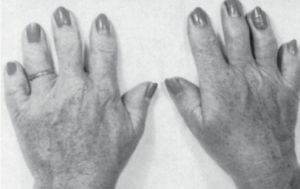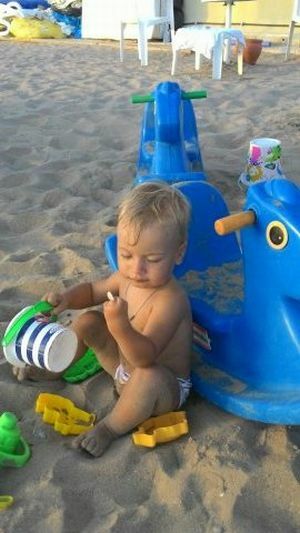 Anomalies of the innate nature of the hand are observed in most cases of all anomalies of the upper limbs. At the moment, scientists are making polydactyly, syndactyly, oligodactyl and other deformations of the hand and fingers.
Anomalies of the innate nature of the hand are observed in most cases of all anomalies of the upper limbs. At the moment, scientists are making polydactyly, syndactyly, oligodactyl and other deformations of the hand and fingers.
The most rare of these is oligodactyl. It is a decrease in the normal number of fingers, where instead of five on the brush develop 2 or 3 fingers.
In this case, they can be spliced or underdeveloped, and the brush itself is split. The performance of its functions directly depends on the degree of defect. In most cases, this anomaly is symmetrical and is inherited.
Causes and risk factors for
The causes of development of oligochactil are divided into two groups. The first includes congenital anomalies of the brush in the child's parents. In this case, the probability of the birth of a baby suffering from such an anomaly is extremely high.
Other endogenous factors( "overexposure" of germ cells, endocrine diseases of parents or the age of more than 35 years) are also attributed to causes that cause congenital anomalies.
The second group includes the negative impact on the pregnant woman, that is, exogenous factors. If during pregnancy mum abuses alcohol or tobacco, all this will affect the health of the baby. 
This group also includes severe infectious diseases that were suffered during pregnancy, a constant exposure to harmful chemicals, ultraviolet rays, radiation, etc.
For this reason, the risk group includes pregnant women living in adverse areas with poor ecology. The inhabitants of the city are facing oligochacty more often than people from small settlements.
Symptomatology from the embryo to the birth

In the photo, a child with congenital oligochtilia
Oligodactyly is an embryopathy, i.e., embryo damage from the moment of fixation to the wall of the uterus until the formation of the placenta, causing malformations of individual organs.
As in the embryonic period the formation of the basic organs occurs, most congenital anomalies appear precisely in this time interval.
Critical periods, that is, the stages of intensive development of certain organs, when they are most susceptible to injury, determine the degree of manifestation of the defect after birth.
Oligodactyly is characterized by shortening of the first and second fingers of the hand, violation of the normal shape of the thoracic spine, complete absence of the radius, abnormalities in the development of the kidneys.
Sometimes the developmental defects of the fibula of the lateral parts of the foot may be detected.
After the birth of a child, specialists using X-ray detect the defect in the development of the facial skeleton or underdevelopment( complete absence) of the ray elements of the brush.
Prenatal diagnostics
Prenatal diagnosis has a great opportunity to diagnose congenital malformations, which makes it possible to increase the effectiveness of fighting them. The main method of diagnosis is ultrasound, which is carried out at three main levels:
- General obstetric ultrasound , which is performed by doctors of female consultations. At this stage it is determined whether the fetus is in conformity or not in accordance with the necessary norms.
- Specialized prenatal ultrasound , which is performed in medical universities and medical centers devoted to genetics. Its purpose is to clarify the information about fetal anomalies, identified in the first stage. Often, the preset diagnosis can be completely revised after a special ultrasound.
- Expert prenatal ultrasound , necessary to determine the final diagnosis and develop effective treatment. At this level, the latest diagnostic techniques and invasive methods are used. The results of the studies are usually analyzed by a whole staff of doctors.
If ultrasound examination revealed a surgical pathology of the fetus, the last word is left to the doctor by a neonatology surgeon, which determines the nature of the defect: corrective or uncorrectable.
In the latter case, experts recommend aborting the pregnancy.
Treatment Methods
Treatment of oligochactia can be conservative or operative. In the first case, specialists prescribe therapeutic procedures, for example, thermal interaction, massage with stretching and redression of the skin. 
With their help the further development of the disease is prevented and thanks to which the patient is prepared for surgical intervention. Corrective dressings can also be used to create pressure and tension in the area of the hand in order to fix it in the required position.
The main place in the restoration of functions with congenital defects of the hand belongs to the surgical intervention, the organization of which until now can not be called impeccable, despite the success of microsurgical techniques.
There is no consensus on the age limits of surgical treatment, its most effective methods have not been determined, but its relevance can not be denied. Most often, operative correction begins with 7-8 years, but in some cases it can be carried out earlier.
The choice of the method of operation depends on the progressiveness and shape of the anomaly. Anomaly can be eliminated with the help of complicated plastic operations, for example, a finger transplant from another limb( legs).Operation Nikodoni is used to eliminate the defect of the first finger of the brush.
In some cases, a procedure is used with the Filatov stem, into which a bone or an acicular phalanx is inserted. After surgical intervention, as the child grows, additional deformation correction is necessary.
Congenital abnormalities of the hand - this is a serious pathology, requiring a responsible approach to choosing a method of treatment, thorough operating technique and intensive rehabilitation.
Each stage should be conducted under the supervision of experienced specialists in highly specialized medical departments. During surgery, it is necessary to eliminate all deformations at one time, since this technique brings the best result.



